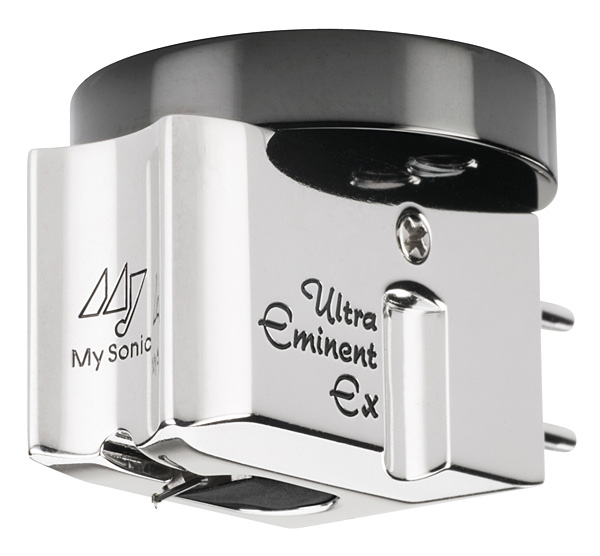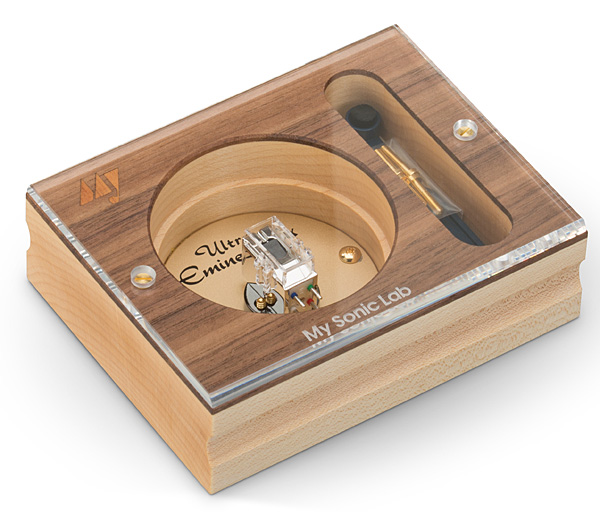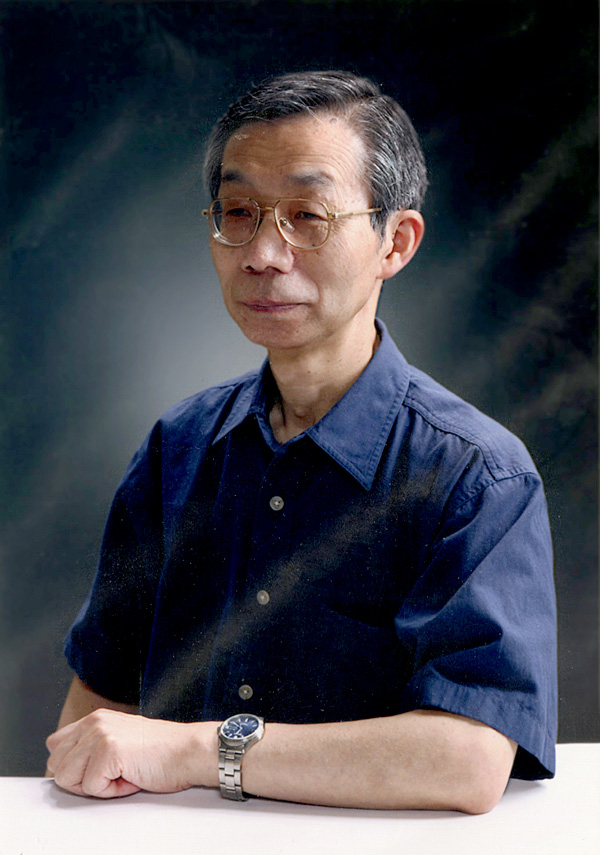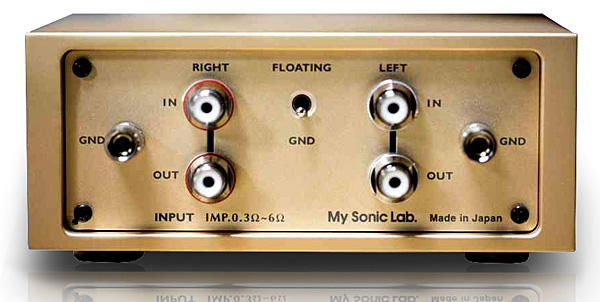| Columns Retired Columns & Blogs |
Have you tested the the iOS-based RPM app from iTunes with the now discontinued Feickert app for speed accuracy?
My Sonic Lab Ultra Eminent Ex cartridge
One quiet midsummer morning, sunlight was penetrating the slots of my bamboo shades, casting thin ribbons of light across my room—a magic Koetsu black-disc morning. I'd just finished dreaming through both sides of the Reynaldo Hahn LP with the Koetsu in the Feickert Blackbird when suddenly I got the urge to switch from shiny rosewood to shiny aluminum alloy and install My Sonic Lab's Ultra Eminent Ex moving-coil cartridge ($6995). The Ultra Eminent Ex was well broken in—it had over 50 hours on it because I loved it immediately when I first installed it in the AMG Giro G9 turntable-tonearm combination; it was already properly aligned, and mounted in a second Jelco HS-20 headshell, ready for a spin in the Feickert-Jelco combo. All I had to do was set the vertical tracking force (VTF) to 2gm, increase the loading on the Tavish Design Adagio phono stage from 100 to 200 ohms, and start the record over. I was primed for a comparison.

What I heard was a more grain-free piano and a more testosterone-infused version of Bruno Laplante's baritone. What struck me most was how much the Ultra Eminent Ex's presentation sounded like analog tape. I believe this was caused by extreme amounts of low-level detail. The Eminent Ex retrieved so much microdetail that I swore I could hear right through the grooves to the analog tape passing across the recorder's playback head. Laplante's voice and Janine Lachance's piano seemed more together in the same space. Lachance's right-hand notes seemed more in tune and flowing, more as if played by an actual human hand. The sound between the speakers seemed particularly un-hi-fi—less mechanical than any other MC I've experienced. The My Sonic Lab presented music with a powerful but nonchalant expressive force—like live music.
The Ultra Eminent Ex excavated so much microlevel information that it seemed to reach some perceptual limit where recorded detail is no longer perceived as "detail" per se, but instead begins to materialize into the person, instrument, or environment the information represents.

Whenever I say that a hi-fi system sounds "real" or "life-like," I mean that my conscious perceptions have shifted from such left-brain concepts as frequency response, distortion, and resolution to the actual physical bodies of human beings and musical instruments, and the spaces they perform and are played in. My Sonic Lab's Ultra Eminent Ex accomplished this shift of perception better than any DAC or other cartridge I know. I believe the ultimate goal of all audio engineering is a simple one: believable corporeality.
Which is exactly what My Sonic Lab founder and chief engineer Y. Matsudaira's combination of low internal impedance—0.6 ohm DC resistance and high output potential (0.3mV/1kHz—appears to have achieved.

According to Jonathan Derda, national sales and marketing manager of MoFi Distribution, which distributes My Sonic Lab in the US:
"Previous to founding My Sonic Lab Y. Matsudaira worked with Yoshiaki Sugano and was a major part in developing the original Koetsu Onyx cartridge. The two had met previously at Supex. Early in his career while Matsudaira-san worked with Sugano, he also designed a cartridge for Luxman, which is how he met Miura-san [of Air Tight]. They developed a relationship which many years later led to Matsudaira designing and manufacturing cartridges for Air Tight while he was with Audio Craft. In 2004, after three decades of designing and building MCs for nearly every top Japanese cartridge manufacturer, Matsudaira started My Sonic Lab. He still does OEM/ODM for many of Japan's top brands."
See? Artists and wizards do form secret cults in faraway places.
Derda continued: "Matsudaira says there hasn't been any real innovation in cartridge design in the last 40 years. The one problem that always bothered him was how to increase signal output without increasing the number of coil turns required, which as you know is a trade-off of loss of information, responsiveness, phase accuracy, ringing, etc. He had an unwavering vision to eliminate those trade-offs. It was a fateful occurrence that led him to meet a laboratory researcher involved with the development of magnetic material. The discovery of this new core material, SH-ÊX, allowed Matsudaira to replace the commonly used iron alloys, and create his dream MCC with the lowest amount of signal loss combined with the highest relative output."
My Sonic Lab Stage 1030 step-up transformer
A lifetime of personal analog experiments reached a higher plane when I let My Sonic Lab's Ultra Eminent Ex MC cartridge drive their Y. Matsudaira–designed Stage 1030 step-up transformer. The Stage 1030 reminded me how true audio verity is always simple, solid, very three-dimensional, and not artificial in texture. Musicians were suddenly more dense, 3D, and tangible. Less hi-fi. I realized all this the moment the voice of countertenor Charles Brett surfaced above the orchestra and organ in Purcell's "They that go down to the sea in ships," with George Guest leading the St. John's College Choir, Cambridge, and the Academy of St. Martin-in-the-Fields (LP, Argo ZHG 5444). His voice was so immediate and forceful that it startled me. I could feel Brett's chest and ribcage. I could sense his mouth forming words. I had never experienced any digital sound this vivid, tangible, or satisfying. Contrasts of hard and soft, loud and quiet, near and far, plus the spaces between singers, were rendered with a captivating, nonchalant precision. This is the music of cathedral choirs at its most engaging. The voices of tenors Robert Tear and Wilford Brown put my eyes and ears inside the Chapel of St. John's College, Cambridge.

Please understand, when I walk to the grocery store, I sometimes close my eyes and listen to the dome of sound around me: trucks making apocalyptic bass, fire engines screaming unbearably loud, neighbors chattering their greetings, and, most obviously—no grain in any of these the sounds.

Real life is never grainy. Neither is the sound of my records through My Sonic Lab's Ultra Eminent Ex low-impedance MC cartridge and Stage 1030 step-up transformer. Combined, these two Y. Matsudaira creations made LPs sound as close to 3D-live as I have ever heard.
Dr. Feickert Analogue Blackbird
Before the Dr. Feickert Analogue Blackbird turntable arrived, I spent many hours with the Koetsu Rosewood Signature Platinum and My Sonic Lab Ultra Eminent Ex attached to both my Linn LP12 turntable and SME M2-9 tonearm, and the all-out AMG Giro G9 combo ($10,000), which bundles their Giro turntable with their 9W2 tonearm.
It was not close. Both cartridges sounded much more as they should on the AMG player. The 9W2 tonearm on the Giro is where I first discovered the unique corporeality of My Sonic Lab's Ultra Eminent Ex. It also made me realize that my SME M2-9 arm wasn't handling the energy imparted by the Koetsu Rosewood Signature Platinum's low compliance. When I swapped the Koetsu from the Linn to the AMG Giro, the lighting of soundstages got darker, with less hashy energy at 1kHz. Empty spaces became deeper, more abyssal. Textures and tone colors bloomed, imbuing voices with Koetsu's signature vividness. Both expensive cartridges sounded more expensive on the AMG.
Then I switched to the Blackbird, hoping to learn as much as I could about the intrinsic sound of Feickert's two-motor turntable and the new knife-bearing Jelco TK-850L tonearm.
For the first week, I focused on the Jelco arm. I discovered that it was more of a steady-in-the-groove cartridge guide than either SME M2-9 or AMG 9W2. I verified that surprising impression by systematically comparing the AMG, SME, and Jelco arms (with the Koetsu) with An Audio Obstacle Course: Era III (LP, Shure Bros. TTR-110) and The Ultimate Analogue Test LP (Analogue Productions AAPT1).
What surprised me most was how lively and expressive the Blackbird was. Bass through the Feickert-Jelco combo was tighter and more vigorous than the AMG. Compared to the AMG G9 and my Linn LP12, the Blackbird's momentums felt noticeably more visceral.
Overall, the AMG record player had superior octave-to-octave energy balance. The AMG made music feel whole, even-tempered, and coherent. But that coherence could also seem a touch dark and ponderous. In contrast, the two-motor Feickert generated a more lively, spirited, engaging sound. The AMG brought a firm, steady hand to Classical-era orchestral music, while the Feickert brought spark and fierce spirit to the German Romantics. Both are superfine, expensive record players, but with personalities different enough that potential buyers should take care in choosing the one that best matches their own temperament.
Conclusions
Maybe twice per decade I encounter an audio product that I know is truly me: a product that delivers the tone, life, and fundamental temperament I value. The original Koetsu Rosewood Signature, the Linn Sondek LP12 turntable, the BBC/Rogers LS3/5a monitor speaker, and, most recently, the Pass Laboratories XA25 amplifier and Harbeth M30.2 Monitor loudspeaker are classic Herb products. These "me" products must not only sound the way I like, they must be engineered and built in a way I can understand and admire. Well then . . .
Praise Heaven! It seems I've just discovered five new Herb products in a single installment of "Gramophone Dreams."
I admired the Dr. Feickert Analogue Blackbird the minute I set it up. It looked and felt so simple, solid, and right. I liked it even more after I played a few records. After a couple of weeks, I was ready to propose marriage. This turntable begs for two arms, and seems perfect for doing tonearm reviews. The SME 3009 tonearm, with its knife-edge bearings, was also a big Herb product. Now I'm stone crazy for the knife-edge bearing Jelco TK-850L. I appreciate its high, rock-solid PRaT and its dynamic sound, and its removable headshell perfectly suits my phono-cartridge obsession.
What other makers of MCs can boast almost five decades of making the planet a more beautiful and sophisticated place? Maybe EMT, certainly Ortofon, but my vote goes to Koetsu. The Rosewood Signature Platinum is a supreme Herb product.
Finally, I'm happy to report that, with the introduction of My Sonic Lab's Ultra Eminent Ex phono cartridge and Stage 1030 MC step-up transformer, the realm of phonography has just gotten bigger, more solid, more truthful, and a lot less noisy. Unquestionably, these Y. Matsudaira designs delivered some of the finest phonography I have experienced.
These five analog products are all superior in ways I have only began to appreciate. Thank you, MoFi Distribution, for bringing them all together in my Bed-Stuy studio.

... the following article was written that might make a MC cartridge seem - in HR's opinion - to provide a closer approximation to the sound of the master tape than a MM cartridge?
http://www.regonaudio.com/Stanton881AudioTechnicaATML70.html
Recall that AR once determined that LP playback via a Shure V15 Type IV (MM type) cartridge resulted in sound quality most closely approximating that of the master tape.

Herb,
I have read your rejection of the Sota Sapphile/Sumiko MMT combination a few times. As the almost 30 year owner of what is probably a contemporary Sota/MMT turntable it makes me sad. However it also makes me a bit upset as people may not consider a beautiful turntable based on your comments.
I did go many years thinking it was a good, if not great combination, but two changes I have made in the last couple years has made me totally realize where the weaknesses are - and it isn't with the basic turntable or tonearm.
My first improvement was changing the stock phono cable with a Kimber TAK model. The sound which had been very detailed and a bit lacking in fullness was changed to a much more musical tone.
But what made the biggest change - and where I think the Series III Sapphire was most lacking - was in the armboard. I found a acrylic/aluminum Sota armboard that was drilled for my arm online for a good price. When I moved the arm to the new board - double checking the pivot to spindle distance which was slightly off on the original mounting and re-balancing the table for the heavier board - the first notes were a revelation. Percussion was MUCH tighter, all sounds had much more ease to them, and I even think the speed accuracy was improved.
The biggest drawback to the tables of that era was the press board armboard. And either of the new improved armboards can be retrofitted to any Sota Sapphire and up turntable.
Stereophile has not reviewed a Sota product in some time and it is no longer on your recommended list. With the new Series VI coming out soon, I think it would be a good time to re-introduce your readers to the current performance level of Sota turntables.
Matt

The Halo JC 3+'s sound is gentle and finely detailed, with touches of softness in the bass and extreme treble—but when set to load the expensive Rosewood Platinum Signature at 100 ohms, the result was an exceedingly rich and unaffected sound. The combo allowed baritone Bruno Laplante and pianist Janine Lachance to sound as if they were giving a real recital in a real recital hall in their recording of Reynaldo Hahn's song cycle Mélodies Vol.2 (LP, Calliope CAL 1840). I could sense the polished wood floors and room parameters. https://www.psiphon.onl